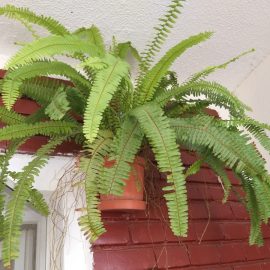Ferns, plant care and growing guide
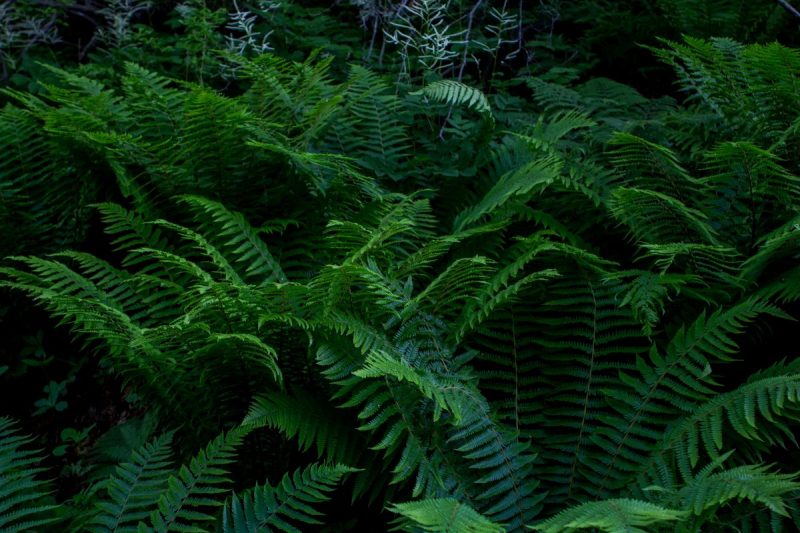
Ferns are a group of prehistoric plants that includes over 10,000 known species. They are vascular plants, with roots, stems, and true leaves. Ferns do not produce flowers or seeds. They multiply through spores, which are located on the lower part of the leaves. Ferns are most widespread in tropical areas, but can also be found in mountainous areas, some species growing even in the polar region. They have variable heights depending on the species, from 1-2 cm to 10-25 m tall trees. Are invasive plants, which spread very easily with the help of their underground rhizomes. The leaves’ shape and size vary depending on the species, from simple, small and round, to large, divided leaves. Most ferns have two types of leaves: those responsible for photosynthesis and those responsible for multiplication.
Genus and species
They grow both as perennial species and as indoor/outdoor decorative species. Among the decorative ferns, the most common are:
Polystichum setiferum is called the soft shield fern and is native to forests in the mountainous regions of Europe. It has large, compound leaves with divided, green leaflets. It can grow both indoors and outdoors, in shady or partially shaded places, protected from the sun.
Pteris spp. It is a genus of ferns native to Europe, South Africa, Asia, Australia, and New Zealand, and consists of a rosette with the aspect of a bush. They can be grown both as outdoor and indoor plants in pots. Depending on the species, the leaves can be green or brown and can be more or less divided. It needs moderate light, prefers shade, and should not be exposed to direct sunlight.
Pellaea rotundifolia is a species native to Africa, North and South America, it is a small fern, with leaves made of rounded, dark green leaflets. Like the other ferns, it can be kept both outdoors and indoors, and it needs a slightly shaded place, protected from direct sunlight.
Nephrolepis exaltata is a fern with large, divided leaves, which give the plant the appearance of a compact bush. It originates from tropical areas, and in other countries, it is often grown in pots, both indoors or outdoors (in summer). This plant prefers shaded places and should be placed near windows with northern or eastern exposure. It has several varieties, the most special being: Bostonensis, or Boston fern with the shape of a large bush; Cordatas, with very curly leaves; Erecta with wavy leaves.
Didymochlaena truncatula is native to the tropical forests of Asia and Africa, it has long, double, feather-like leaves, with a glossy surface. It prefers partially shaded places, away from strong sunlight. It can be grown in the garden or indoors, in pots.
Blechnum gibbum is native to South America and New Caledonia, it has a bush shape, with long, feather-like leaves, which are very divided. Sometimes it can form a short trunk, having a tree-like appearance. It can be grown indoors, but also in the garden. It prefers bright places but should be placed away from the windows, to protect it from direct sunlight.
Davallia mariesii is a fern native to the tropics of Asia and Fiji, called “the squirrel’s foot fern” due to the thick rhizomes, with brown fuzz, resembling squirrel’s paws. The leaves are large and rigid, very divided, triangular. Unlike other ferns, it prefers bright places, but it still needs to be protected from direct sunlight. It is recommended to place it in hanging planters, indoors, or in the garden (in summer).
Dicksonia antarctica is native to Australia and is a fern tree, with very long leaves, which can reach a height of 2 m in the wild. Like Davallia, it needs bright light, but it should not be placed in direct sunlight. It is often grown in pots, outdoors, or in the apartment.
Asplenium spp. it is a genus that includes about 700 species of ferns, originating from Asia, Australia, and Africa. The bush shape differs depending on the species, as well as the leaves, which can be simple or compound, and strongly divided. It is suitable for growing indoors, in hanging planters, placed in areas protected from direct sunlight. Among the species that comprise this genus, the most special is Asplenium bulbiferum, which has divided leaves and bulbs, and Asplenium nidus, with broad, simple, compact leaves, similar to a banana tree.
Alsophila australis or Cyathea australis is a fern tree, native to Australia, which has a thick trunk, consisting of stems that are constantly renewed. The leaves are large, flared-out, and light green. It can be grown indoors, in pots, where it rarely reaches a height of 2 meters. In summer, between May and September, it can be kept in the garden. It needs bright light, but direct sunlight can affect it.
Adiantum raddianum, called the Delta maidenhair fern, is a fern with fine, rounded green leaves, attached to blackish, thin dangling stems. It originates from Brazil, and it is often grown as an indoor plant, in hanging planters. It should be placed next to a window with a northern exposure, protected from direct sunlight.
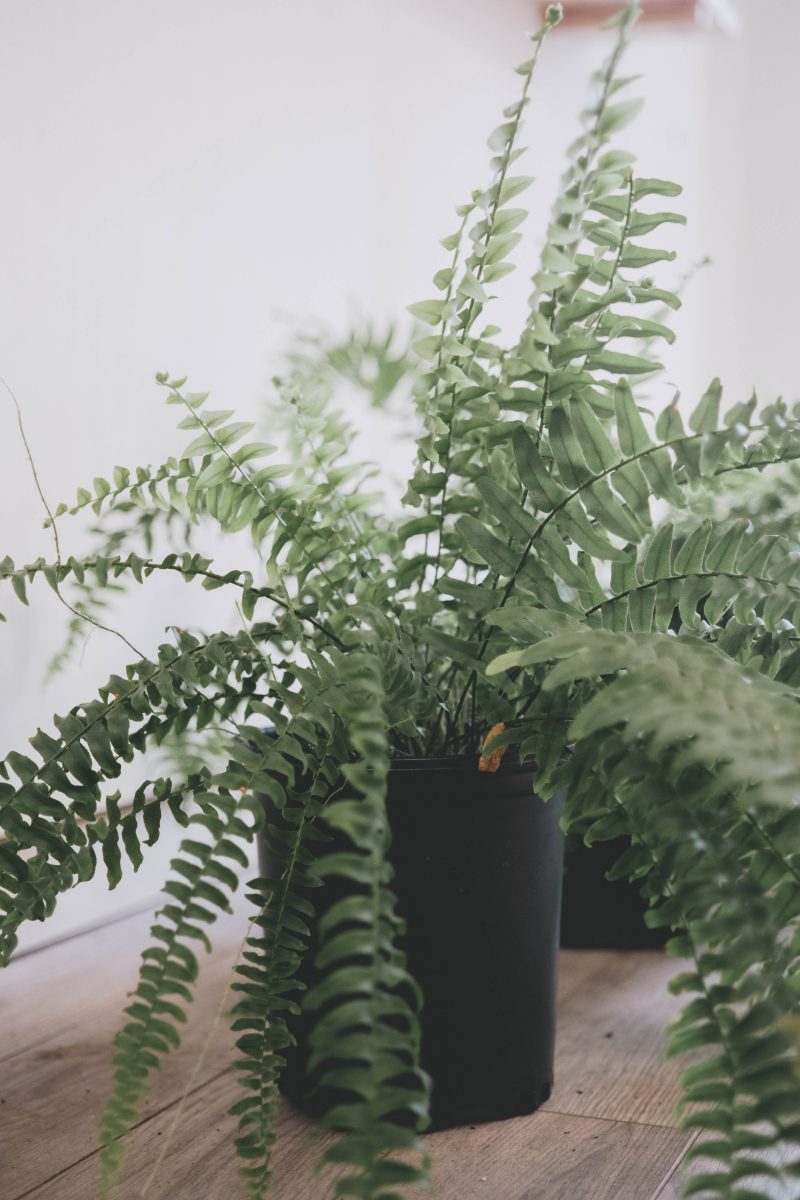
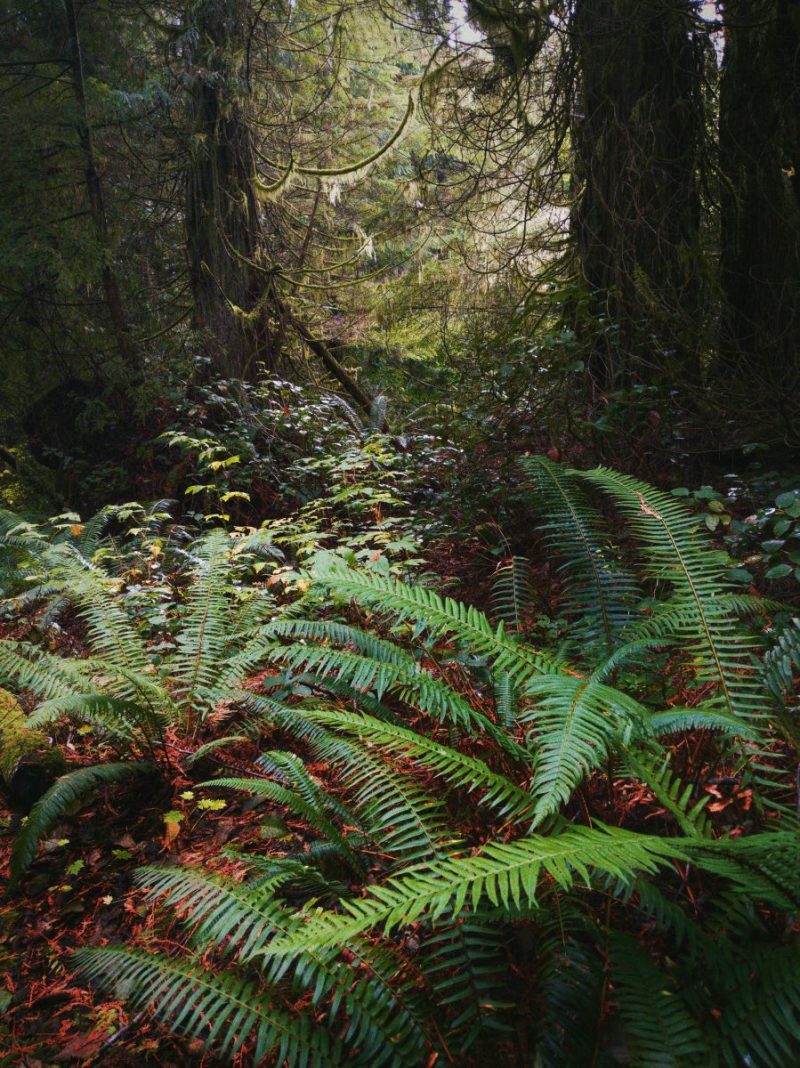
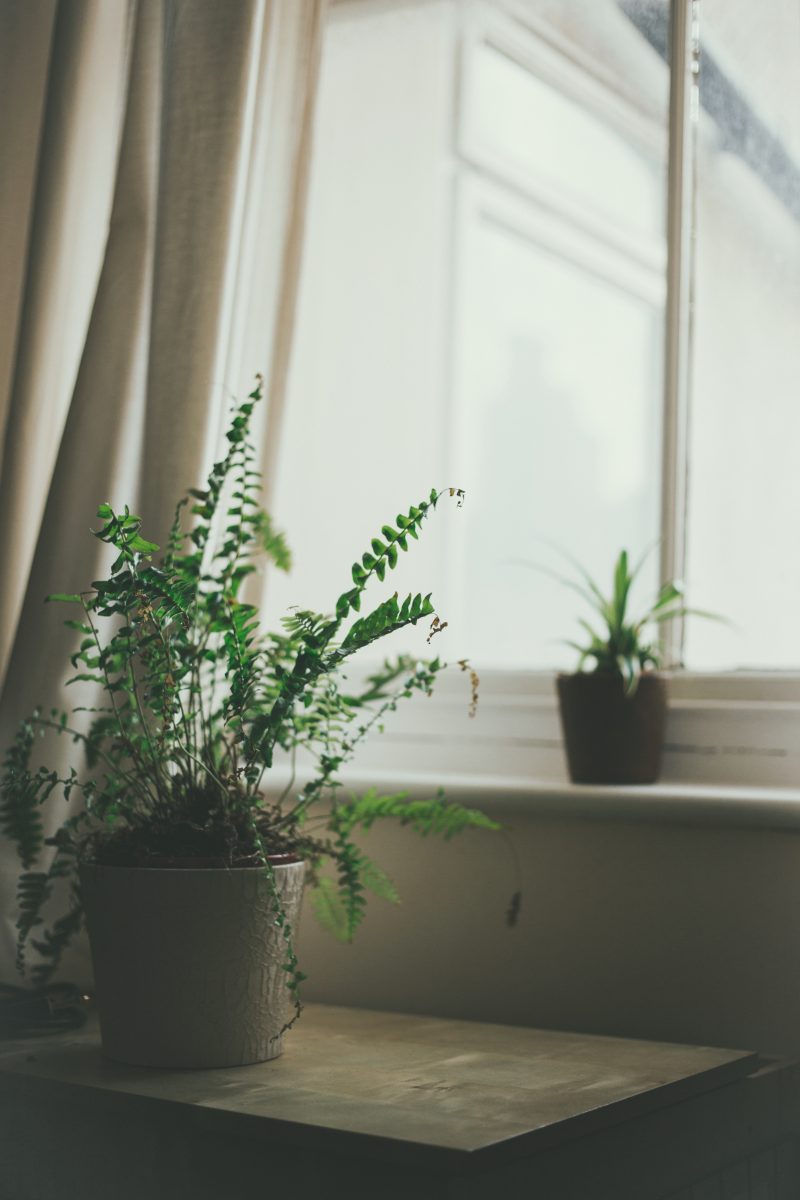
Environmental requirements
Light
Most species of ferns grow optimally if placed in shady or partially shaded places, like their natural environment. Some species such as Blechnum gibbum, Davallia mariesii, Dicksonia antarctica, and Alsophila australis prefer bright places. However, regardless of the species, ferns should be protected from direct sunlight, which could cause leaf burns.
Temperature
Most ferns grow well at an optimum temperature between 18 and 22° C. The minimum temperature it can withstand may differ depending on the genus and species, as follows: Pteris, Pellaea, Didymochlaena, Blechnum, Asplenium cannot withstand temperatures lower than 12-13° C.
Davallia and Adiantum can withstand a minimum temperature of 10° C.
Nephrolepis and Alsophila can withstand a minimum temperature of 7° C.
Polystichum, originating from the forests in the temperate continental climate of Europe, where temperatures are generally low, can withstand minimum temperatures of up to 0° C.
Humidity
In general, ferns prefer environments with high atmospheric humidity, about 60%, similar to conditions in tropical or mountain forests. Dry air can affect them, causing the leaves’ tips to dry out. Asplenium, Alsophila and Polystichum have the highest humidity requirements – 60% and must be sprayed daily with water. Ferns of the genera Pteris, Nephrolepis, Didymochlaena, and Dicksonia prefer an average humidity between 50% and 60%, so it is recommended to spray the leaves with water once or twice a week when the temperature exceeds 20° C. Pellaea, Blechnum, and Adiantum are ferns that can withstand the dry air more easily, but not for a long time. Therefore, it is recommended to place the pot on a tray with damp gravel. Davallia is one of the few ferns that have no requirements for atmospheric humidity, being able to grow in rooms with drier air.
Substrate
For most fern species, the substrate must be porous, moist, rich in humus, like the soil in the wild. It can be made of peat, gravel, garden soil, to which you can add good quality compost and river sand to improve drainage. As for pH, ferns generally tolerate a slightly acidic substrate, with the exception of Adiantum (the Delta maidenhair fern), which prefers a slightly alkaline pH.
Recommended products
-
You can find products on a different store
Change Store -
You can find products on a different store
Change Store -
You can find products on a different store
Change Store -
You can find products on a different store
Change Store -
You can find products on a different store
Change Store -
You can find products on a different store
Change Store -
You can find products on a different store
Change Store -
You can find products on a different store
Change Store -
You can find products on a different store
Change Store -
You can find products on a different store
Change Store -
You can find products on a different store
Change Store -
You can find products on a different store
Change Store -
You can find products on a different store
Change Store -
You can find products on a different store
Change Store -
You can find products on a different store
Change Store -
You can find products on a different store
Change Store -
You can find products on a different store
Change Store -
You can find products on a different store
Change Store -
You can find products on a different store
Change Store -
You can find products on a different store
Change Store -
You can find products on a different store
Change Store -
You can find products on a different store
Change Store -
You can find products on a different store
Change Store -
You can find products on a different store
Change Store
Watering
Ferns prefer damp soils. Therefore, during the vegetative growth period (April-September), watering should be done moderately, when the soil begins to dry on the surface (approx. once every 3-4 days). It is very important that the substrate never dries completely because it could affect the plant. During the dormancy period (October-March), the substrate should be watered less often (approx. once every 7 days). Use water at room temperature and avoid excessive moisture of the substrate.
Fertilization
Fertilization should be done when the plant is in its vegetative growth period, from spring to autumn. It is recommended to use special fertilizer for plants with decorative foliage. During the dormancy period, the fertilizer administration must be stopped. It is very important to respect the dosage and frequency of fertilizer application, the excess leading to root burning and leaves drying.
Recommended products
-
You can find products on a different store
Change Store -
You can find products on a different store
Change Store -
You can find products on a different store
Change Store -
You can find products on a different store
Change Store -
You can find products on a different store
Change Store -
You can find products on a different store
Change Store -
You can find products on a different store
Change Store -
You can find products on a different store
Change Store -
You can find products on a different store
Change Store -
You can find products on a different store
Change Store -
You can find products on a different store
Change Store -
You can find products on a different store
Change Store -
You can find products on a different store
Change Store -
You can find products on a different store
Change Store -
You can find products on a different store
Change Store -
You can find products on a different store
Change Store -
You can find products on a different store
Change Store -
You can find products on a different store
Change Store -
You can find products on a different store
Change Store -
You can find products on a different store
Change Store -
You can find products on a different store
Change Store -
You can find products on a different store
Change Store -
You can find products on a different store
Change Store -
You can find products on a different store
Change Store
Repotting
Most ferns require repotting each year in the fall, after the foliage has dried, or in the spring, at the beginning of the growing season. Exceptions are Didymochlaena, Blechnum, and Davallia, which must be repotted less often, once every 2-3 years. Unlike the others, the Delta maidenhair fern (Adiantum) does not require repotting until the roots come out of the pot. Always choose a larger pot, so that the plant can grow properly. It is important that the repotting is done with great care because, in spring, the young leaves are fragile.
Propagation
Most ferns are propagated by sowing spores, in warm weather (about 25° C), in a substrate made up of peat and sand, in the mini-greenhouse. However, this procedure is quite difficult and it is recommended to be done by specialists. Some genera, such as Adiantum, Pellaea, Pteris, and Nephrolepis, can be propagated by separating mature bushes. Davalia can be propagated by cutting off portions of the rhizomes (which have two leaves) and rooting them in planting soil; the roots will form within approx. 2 months.
Recommended products
-
You can find products on a different store
Change Store -
You can find products on a different store
Change Store -
You can find products on a different store
Change Store -
You can find products on a different store
Change Store -
You can find products on a different store
Change Store -
You can find products on a different store
Change Store -
You can find products on a different store
Change Store -
You can find products on a different store
Change Store -
You can find products on a different store
Change Store -
You can find products on a different store
Change Store -
You can find products on a different store
Change Store -
You can find products on a different store
Change Store -
You can find products on a different store
Change Store -
You can find products on a different store
Change Store -
You can find products on a different store
Change Store -
You can find products on a different store
Change Store -
You can find products on a different store
Change Store -
You can find products on a different store
Change Store -
You can find products on a different store
Change Store -
You can find products on a different store
Change Store -
You can find products on a different store
Change Store -
You can find products on a different store
Change Store -
You can find products on a different store
Change Store -
You can find products on a different store
Change Store
In addition:
- ferns are not susceptible to pest or disease attack.
- it is recommended to cut the dried leaves regularly.
- when repotting ferns, a handful of organic fertilizer should be added to the new substrate.
- ferns cannot withstand well sudden temperature variations .
- is not recommended to use foliar fertilizers for shiny leaves.
- Blechnum is sensitive to low temperatures.
- unlike other ferns, Asplenium can be infested by mealybugs.
- Alsophila should be tutored when it grows older.
- the Delta maidenhair fern (Adiantum) should not be moved often and cannot tolerate smoke














































































































































































































































































































































































































































